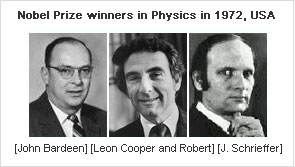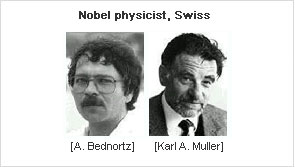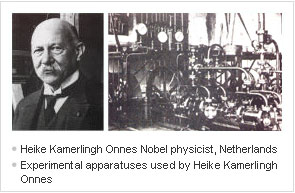
- >
- Superconductivity
- >
- Superconductivity History
Superconductivity History
| Superconductivity Discovery |
In 1908, Prof. Heike Kamerlingh Onnes at Leiden Univ. succeeded in liquefying the Helium gas at absolute temperature 4.2K in his research laboratory, and was experimenting measurement of the metal resistance at cryogenic condition in 1911.
During measuring electrical resistance while solid mercury was cooled using liquid Helium, he confirmed that resistance of mercury suddenly drops to zero near 4.2K which is the vaporization temperature of liquid helium. Electrical resistance gradually drops down and suddenly disappeared beyond a certain critical temperature.
This moment was the starting point of superconductivity history. Two years later in 1913, he was awarded the Nobel Prize for Physics in enabling achievement of the cryogenic research by liquefying Helium gas. The materials that the resistance disappears was called as superconductor.
| Discovery of Meissner Effect |

Another historic discoveries in history of superconductivity were German Meissner and Oschenfeld. They discovered the expelling of internal magnetic fields (self-repulsion effect) as well as zero resistance beyond a certain critical temperature.
This perfect diamagnetism of the superconductor was called as Meissner effect.
The Meissner effect together with zero resistance of superconductors are the most fundamental properties in superconductors. The Meissner effect now applies to the highspeed magnetic levitation train.
Meanwhile, theoretical physics was also studied to explain superconductivity phenomenon theoretically. In 1957, John Bardeen, Leon Cooper, and Robert J. Schrieffer established the superconductivity theory (BCS theory) and explained the complete principles of superconductivity. By this achievement in 1972, three researchers was awarded the Nobel Prize for Physics.
This innovative superconductors must be used liquid helium for applying in real life, which is costly too much. Because Helium gas necessary for manufacturing liquid Helium is light weight and remains only a small amount in the air and exists in oil wells at near Oklahoma city, USA. Superconductivity phenomenon of low-temperature superconductor (LTS) usually appears at very low temperatures and must use expensive liquid helium. This requires enormous economic costs.
That is, the practical application of LTS has a big barrier of the enormous cost of manufacturing. Among these the historic event took place in material field to produce superconductors in 1986.
| Rise of high temperature superconductor |

In 1986, A. Bednortz and Karl A. Muller of IBM research institute in Swiss discovered that ceramic composites La-Ba-Cu-O which was supposed to be an insulator has superconductivity property at 35K. Accordingly, the rise of high temperature superconductor (HTS) history was opened.
In 1987 they were awarded the Nobel Prize for Physics with the first discovery of the oxide HTS. And subsequently in Jan. 1987, M. K. Wu and C.W. Chu of Alabama University announced Y1Ba2Cu3O7 superconductor composite which has critical temperature of 92K (higher critical temperature than that of liquid nitrogen). Since then, in 1988, Bismuth compounds (Bi2Sr2Ca1Cu2O8) discovered by H. Maeda and Thallium compound (Tl2Ba2Ca2Cu3O10) discovered by Z. Z. Sheng and A. M. Hermann showed 110K and 125K of critical temperatures respectively.
In 1993, A. Schilling in Swiss has successfully synthesized Mercury compound (HgBa2Ca2Cu3O8) which has 133K of critical temperature. Like this, there have been a bunch of discoveries in just a few years. Due to the scientific interests in the new superconductors and high interests of various practical technology developments for applying the superconductors, So huge number of HTS researches on the discovery of new superconductors and its applications have been started in earnest since 1986.


